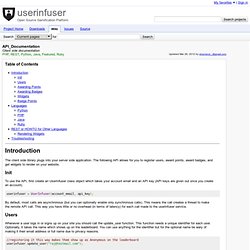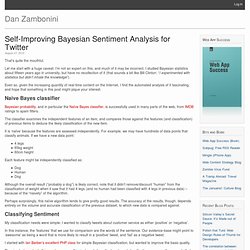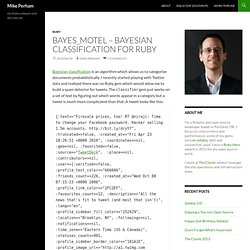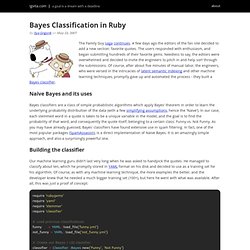

Orp, Inc. Standford University links. API_Documentation - userinfuser - Client side documentation - Open Source Gamification Platform. Table of Contents The client side library plugs into your server side application.

The following API allows for you to register users, award points, award badges, and get widgets to render on your website. Init To use the API, first create an UserInfuser class object which takes your account email and an API key (API keys are given out once you create an account). userinfuser = UserInfuser(account_email, api_key); By default, most calls are asynchronous (but you can optionally enable only synchronous calls). Users Whenever a user logs in or signs up on your site you should call the update_user function. //registering it this way makes them show up as Anonymous on the leaderboarduserinfuser.update_user("raj@testmail.com"); or //this way will show an image and their name on the leaderboarduserinfuser.update_user("raj@testmail.com", "Raj", " " Awarding Points Give points to a user by: userinfuser.award_points("raj@testemail.com", 10, "the reason why"); Awarding Badges To award a badge: Widgets Python.
Self-Improving Bayesian Sentiment Analysis for Twitter. That’s quite the mouthful.

Let me start with a huge caveat: I’m not an expert on this, and much of it may be incorrect. I studied Bayesian statistics about fifteen years ago in university, but have no recollection of it (that sounds a bit like Bill Clinton: “I experimented with statistics but didn’t inhale the knowledge”). Even so, given the increasing quantity of real-time content on the Internet, I find the automated analysis of it fascinating, and hope that something in this post might pique your interest. Naive Bayes classifier Bayesian probability, and in particular the Naïve Bayes classifier, is successfully used in many parts of the web, from IMDB ratings to spam filters.
News Analytics: Analytic Tools for Quantitative Finance, Business & More - Recorded Future. High-Quality Open Source Body Tracking Sans Kinect. New frontiers in artificial ... Fast profile matching algorithms – A survey. Position-specific scoring matrices are a popular choice for modelling signals or motifs in biological sequences, both in DNA and protein contexts.

A lot of effort has been dedicated to the definition of suitable scores and thresholds for increasing the specificity of the model and the sensitivity of the search. It is quite surprising that, until very recently, little attention has been paid to the actual process of finding the matches of the matrices in a set of sequences, once the score and the threshold have been fixed. In fact, most profile matching tools still rely on a simple sliding window approach to scan the input sequences.
This can be a very time expensive routine when searching for hits of a large set of scoring matrices in a sequence database. Bayes_motel – Bayesian classification for Ruby. Bayesian classification is an algorithm which allows us to categorize documents probabilistically.

I recently started playing with Twitter data and realized there was no Ruby gem which would allow me to build a spam detector for tweets. The classifier gem just works on a set of text by figuring out which words appear in a category but a tweet is much more complicated than that. A tweet looks like this: {:text=>"Firesale prices, too! RT @nirajc: Time to change your Facebook password. As you can see, a tweet is just a hash of variables. Some variables don’t work, statistically speaking: :id, :created_at – these variables are unique for each tweet which means they are useless for classification.
There are additional things we could do to improve our spam detector: Bayes Classification in Ruby. By Ilya Grigorik on May 23, 2007 The Family Guy saga continues.

A few days ago the editors of the fan site decided to add a new section: favorite quotes. The users responded with enthusiasm, and began submitting hundreds of their favorite gems. Needless to say, the editors were overwhelmed and decided to invite the engineers to pitch in and help sort through the submissions. Of course, after about five minutes of manual labor, the engineers, who were versed in the intricacies of latent semantic indexing and other machine learning techniques, promptly gave up and automated the process - they built a Bayes classifier. Naive Bayes and its uses Bayes classifiers are a class of simple probabilistic algorithms which apply Bayes' theorem in order to learn the underlying probability distribution of the data (with a few simplifying assumptions, hence the 'Naive').
Building the classifier Our machine learning guru didn't last very long when he was asked to handpick the quotes. Game AI for Developers